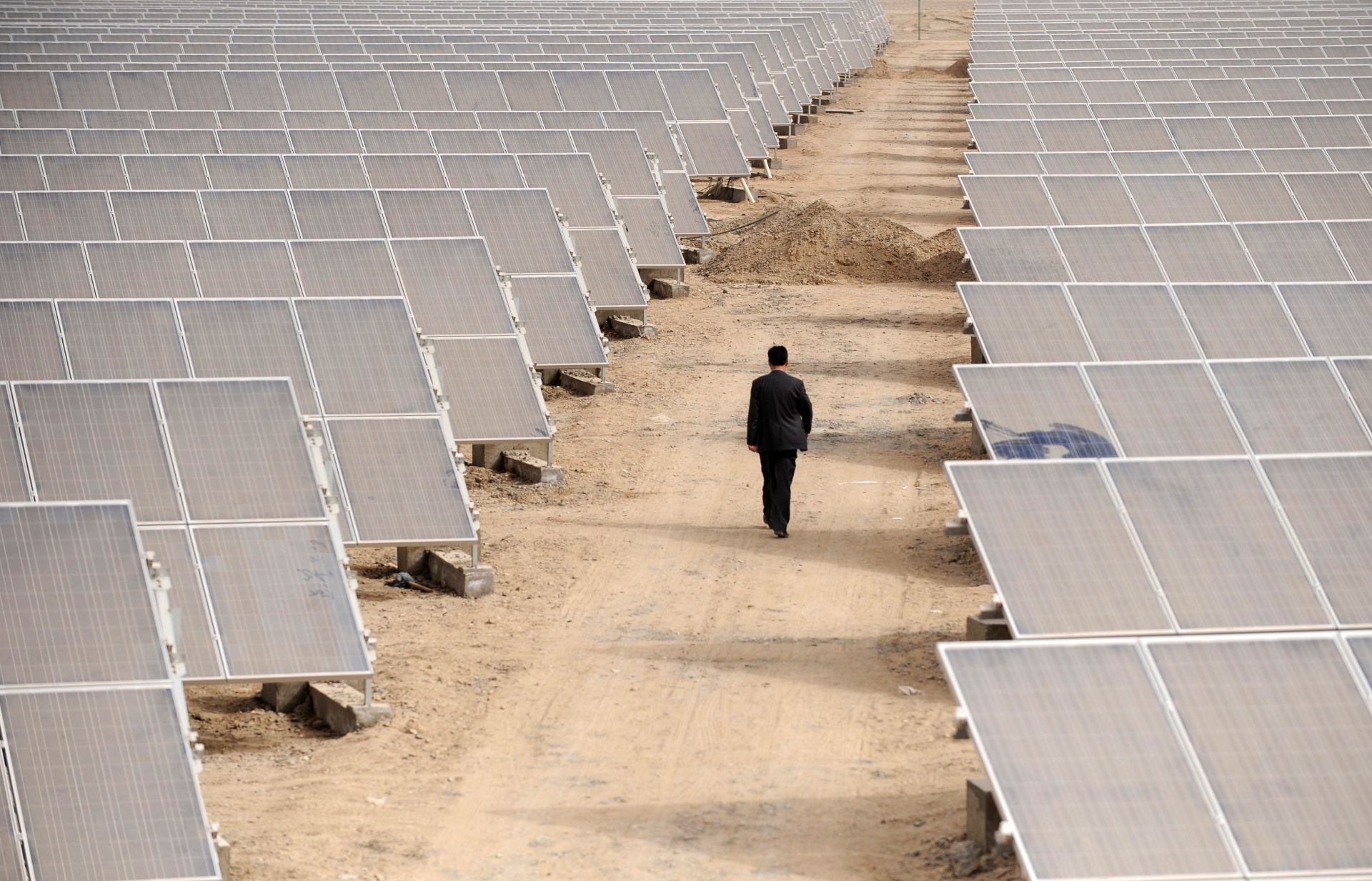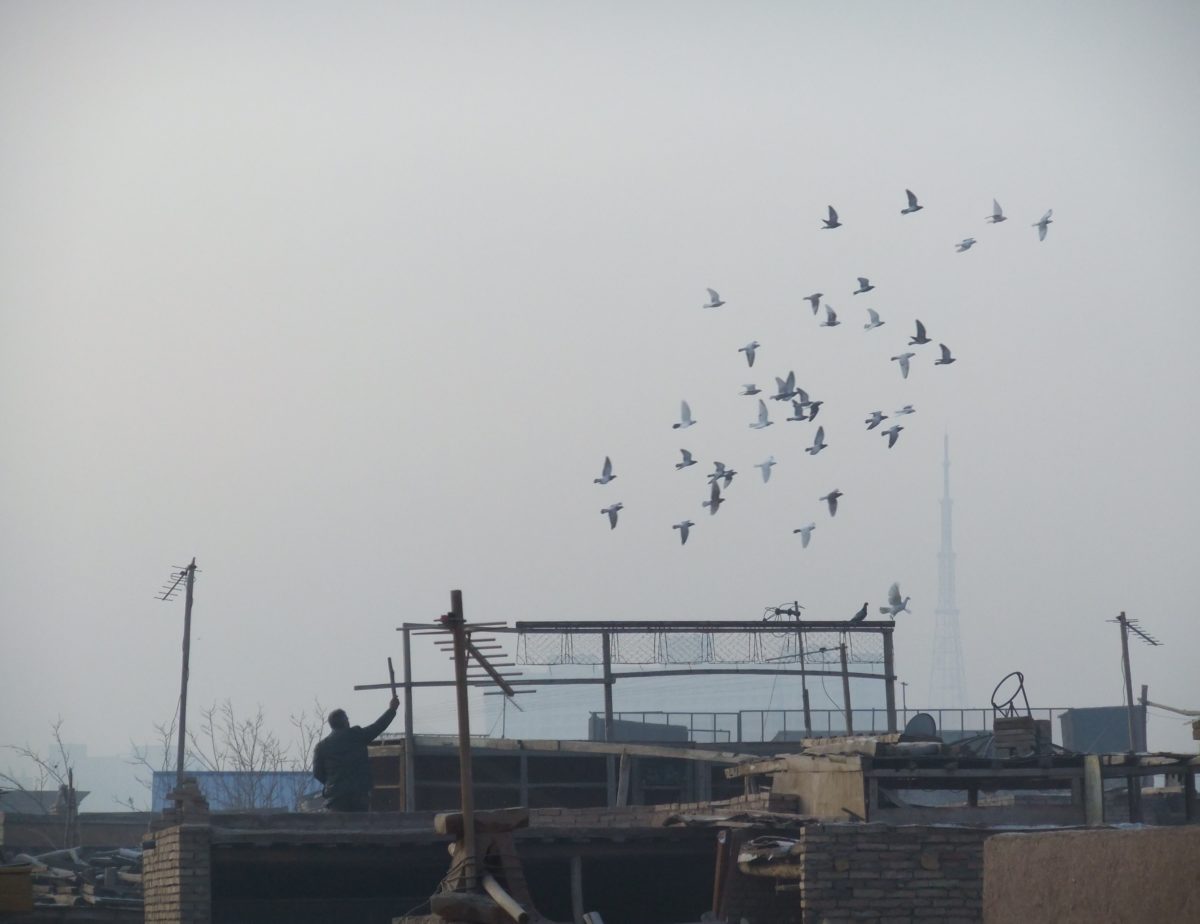The world’s solar panel industry is still powered by Uyghur forced labor
“Clean” and “dirty” supply chains perpetuate modern slavery among Turkic minorities, a report from researchers at Sheffield Hallam University shows.

Every minute in America, 114 new solar panels are installed to help the nation shed its dependence on fossil fuels and meet emissions reduction goals, but the growth of solar power is alarming because much of the equipment used is made by Chinese firms employing coerced Uyghur labor, according to a new report from a British research institution.
When sanctioned by the U.S. Uyghur Forced Labor Prevention Act of July 2021, many companies in the $33 billion solar panel industry began hiding the sources of the raw materials they use by splitting their supply chains: one “clean” supply chain for the U.S., and one “tainted” one for the rest of the world, an August report, Over-exposed: Uyghur region exposure assessment for solar industry sourcing, from The Forced Labour Lab at Sheffield Hallam University in England has shown.
Unless action is taken to stop this supply-chain bifurcation, the growing number of solar panels installed worldwide could perpetuate forced labor among China’s largest Turkic minority. By 2030, when the solar industry hopes to supply 30% of U.S. energy generation, the installation rate will rise six times to reach 350 million panels in total.
While the U.S. risks becoming a “dumping ground” for solar panels made using Uyghur forced labor, Laura Murphy, author of the report from the Forced Labour Lab, told The China Project that European governments now have a chance to lead a change in the direction of the solar industry.
In early September, Norwegian Crystals, a maker of solar-powered bricks, or lights, and the silicon wafers used to build the bigger solar panels, filed for bankruptcy because it was unable to compete in a market flooded with Chinese polysilicon, a key ingredient of solar panels.
The Scandinavian firm’s insolvency struck a blow to the continent’s supply of homegrown solar cells, and shone a spotlight on the need for regional governments to back the local solar industry with resources to combat the Chinese competitors’ Beijing-subsidized advances.
In fact, the European failure could be the first in a wave of imminent “wide-scale bankruptcies in the EU’s solar sector” brought on by Chinese competition, a September 2023 Politico report showed.
“There’s an opportunity for the EU to invest in the diversification of the supply chains to ensure that China’s artificially deflated prices do not mean the end of international solar manufacturing,” Murphy told The China Project.
Asking for help, Solar Power Europe wrote to the European Commission, declaring “fierce competition” between Chinese suppliers to gain market shares as “deeply precarious” for EU industry. Walburga Hemetsberger, CEO of the industry group, told Politico the industry needed “80–100 million” euros ($85.44–$106.8 million) in the “next couple of weeks” to stay afloat.
Though Chinese energy industry giants such as Longi Solar, Trina Solar, and Jinko Solar, among others, promised to quit Xinjiang over the past few years, the Forced Labour Lab report showed that Uyghurs still form the unwilling bedrock of the workforce making cheap solar panels sold to the West.
Underpinning their cost was cheap labor sourced from Uyghurs coming out of two or three years of unlawful detention across the Xinjiang Uyghur Autonomous Region, a remote, sparsely populated area of northwestern China three times the size of France. Beginning in 2016, citing a need to stem terrorism for national security, Beijing policies led to the detention, imprisonment, and forced labor of more than 1 million Turkic peoples, most of whom are Muslim.
Detention and forced labor of Uyghurs and other Turkic Muslims was driven by Chén Quánguó 陈全国, then Party Secretary of Xinjiang. After two or three years of learning patriotic “Red” songs and spoken Chinese, “reformed” Uyghurs were sent around China and forced to work for little or no money making goods for Western markets, Murphy’s report showed.
With funding support from the Modern Slavery and Human Rights Policy and Evidence Centre in London, Murphy and solar industry expert Alan Crawford found that despite a 10% drop in the solar panel raw material polysilicon being sourced from the Uyghur Region since 2020, solar supply chains had become more opaque.
In the wake of the August report — the second of two of its kind from the Forced Labour Lab — Uyghur rights advocates have demanded energy companies clean up their supply chains and stop their “acrobatics” merely to gain access to the lucrative U.S. market.
“Clean energy must be actually clean,” Rushan Abbas, head of Campaign for Uyghurs, a Washington, D.C.–based rights group, told The China Project.
Clean or mean?
After scrutiny of the solar panel supply chain intensified, trade group The Solar Energy Industries Association tried to get companies to shift supply chains away from Xinjiang.
In 2021, more than 340 global companies signed a pledge to rid themselves of forced labor, including 175 Chinese solar companies, but the Forced Labour Lab’s “Over-exposed” report found the abuse continued.
Right at the very first stage of the solar supply chain — digging quartz rock from the earth — Uyghur forced labor is likely to be involved, presenting a moral conundrum to democratic countries trying to transition to clean energy, the report said. China controls at least 80% of global manufacturing for each stage of the solar supply chain.
Murphy and Crawford’s research did a deep dive into the supply chains of 10 solar panel manufacturers, including the top five manufacturers that create 70% of the world’s solar modules combined.
“Despite significant global pressure for increased transparency, information regarding solar industry sourcing is becoming less transparent over time, thwarting the world’s ability to source ethically,” the report said.
According to PV Magazine, the world’s main solar manufacturers, all based in China, are LONGi Solar, Trina Solar, Jinko Solar, JA Solar, Canadian Solar, and Risen Energy. All have a “high” or “very high” potential exposure to Xinjiang, the Forced Labour Lab report said.
Though LONGi and JA set up what they called “clean” supply chains to serve the U.S. or Europe, they still sourced raw materials with links to Xinjiang, the report showed. Information presented to Murphy’s researchers directly by solar companies was “contradictory” and the numbers often didn’t add up.
“Many companies that have created supply chains purportedly free of Uyghur Region inputs continue to source from suppliers or sub-suppliers that have exposure to the Uyghur Region for other product lines,” the report said.
Slow progress
Campaigns to persuade governments to prioritize human rights over profits are painfully slow. In July 2020, the 400-member, nonprofit Coalition to End Forced Labor in the Uyghur Region issued a “Call to Action” to rally brands and retailers to ensure they are not benefiting from the forced labor of Uyghurs and other Turkic and Muslim-majority peoples.
On September 5, 2023, an amendment to a forthcoming U.K. Energy Bill requiring companies to demonstrate that their goods were “not mined, produced or manufactured wholly or in part by forced labor” was debated in Parliament but then put to one side.
Canadian Solar, a Chinese company planning to build in the U.K., is “complicit and among those that try to hide the reality of what they are doing,” MP Alicia Kearns said when introducing the amendment.
“We’re calling for a clean energy transition without Uyghur blood labor staining our countryside,” Kearns said. “Clean energy must not be built on the back of Uyghur slavery.”
Uyghur rights activists were disappointed the amendment did not pass.
“Existing U.K. legislation in the Modern Slavery Act of 2015 does not go far enough to address or prevent the scourge of Uyghur forced labor entering our markets,” Michael Polak, the director of Lawyers for Uyghur Rights, told The China Project. “Amendment 47 would have ensured our government and the British public were not unwittingly complicit in an industry riddled with Uyghur slavery, and doing very little to halt it.”
In March 2020, when the solar industry was warned for the first time to abide by the Uyghur Forced Labor Prevention Act, many companies insisted their supply chains had moved out of Xinjiang.
“The UFLPA needs to be strictly enforced,” Louisa Greve, the director of global advocacy for the Uyghur Human Rights Project, told The China Project. “Even the industry association in the U.S. has been calling on the private sector since October 2020 to change their supply chains without delay, at least in their public messaging. Is three years not enough?”
Greve added that “partial engagement” with Xinjiang was not good enough: “No profits from forced labor are acceptable,” she said.
Energy companies should conduct businesses in compliance with their own ethics policies as well as the law: “Not only the UFLPA but the German due diligence law and the forthcoming EU due diligence law,” she said.
“If they can’t source from a genocidal region, it’s up to them to find new sources,” Greve said, urging companies to lobby Western governments for policy changes that could pave the way for sourcing solar panels’ raw materials economically someplace outside China.
“Myriad problems” stem from the surge of mining the raw materials used to make solar panels, materials such as silicon, silver, aluminum, and copper, Charlie Hoffs wrote in an October 2022 blog post for the Union of Concerned Scientists, founded at the Massachusetts Institute of Technology in 1969.
“Can governments and companies ensure that workers in the solar supply chain benefit from safe, just, and well-compensated livelihoods — and that the communities most affected are involved as active collaborators, treated with respect and dignity?” Hoffs, a former Schneider Sustainable Energy Fellow at Stanford University, wrote.
The world’s much-needed transition from fossil fuels to clean energy from solar power and other sources “must not be at the cost of people’s freedom,” Chloe Cranston, Anti-Slavery International’s business and human rights manager, told The China Project.
“We urgently need governments around the world to introduce policy and financial measures to compel and incentivise the solar industry to shift sourcing,” U.K.-based Cranston said. The USA’s UFLPA was not enough; the U.K., the EU, Canada, Australia, and Japan all needed to get on board with introducing and enforcing import control measures, she said.
For decades, Beijing’s subsidies, cheap Chinese labor, and an extensive use of dirty coal as a cheap source of energy have allowed China to monopolize the solar panel market and block entry to competitors, Cranston said.
Anti-Slavery International advocates supporting cost-competitive alternative sources for solar panel raw materials as long as they meet high social and environmental standards.
“Governments and financial institutions play a critical role in addressing this, including by mobilizing finance and other measures to support the scale-up of alternatives,” Cranston said.
Washington-based Campaign for Uyghurs head Abbas said that the world must ensure that solar companies commit to cutting all ties to slave labor as they chart the path toward renewable energy.
“It is our moral obligation to stand by the Uyghurs, who have endured unimaginable suffering and continue to do so,” Abbas said.
— Jonathan Landreth contributed reporting.






